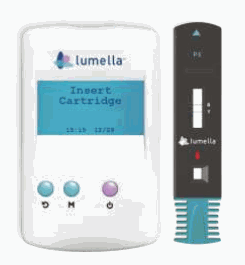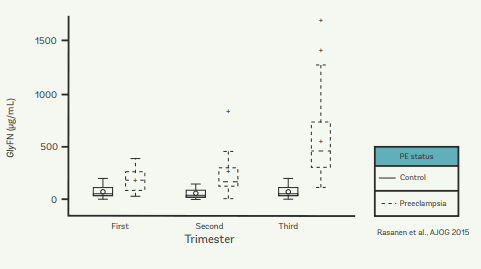Preeclampsia Screening
Accurate Risk Assessment &
Clinical Management
of Preeclampsia
Clinical Management
of Preeclampsia
Introducing the GlyFN ®Lumella rapid point-of care test
The GlyFN Test is Intended as an Aid in the Diagnosis of Preeclampsia in Women with Suspected Preeclampsia.


Early Symptoms of Preeclampsia are often too Ambiguous for Accurate Clinical Stratification
- Clinical presentations often involve uncertain indications of hypertension and proteinuria
- Less than 40% of women exhibit both hypertension and proteinuria before the development of overt preeclampsia
- Preeclampsia progression is unpredictable and often complicated by adverse outcomes
“ Biochemical markers can improve accurate clinical stratification and expectant management ”
Dr. Michael Gravett, Dept of Obgyn, University of Washington Medical Centre, Seattle, USA
Glycosylated Fibronectin (GlyFN) Levels are Elevated in Preeclampsia*
In an observational cohort of 107 pregnant women, 45 normotensive and 62 diagnosed with preeclampsia, glycosylated fibronectin (GlyFN) levels were elevated as early as the first trimester (p<0.001)

*Rasanen et al. Maternal serum glycosylated fibronectin as a point-of care biomarker for assessment of preeclampsia. American Journal of Obstetrics and Gynecology 2015;212:82.e1-9
The Lumella GlyFN Point-of Care Test Accurately Estimates Risk in Women with Suspected Preeclampsia
In a prospective, observational study (SUPERIOR study, 2016-2018), conducted in India among a cohort of 599 women suspected of preeclampsia, GlyFN as a single biochemical marker showed the highest test performance for risk stratification of preeclampsia.
| Normal GlyFN | 50-250 µg/mL | Correlated with normal pregnancy with high sensitivity of 98.2% and high Negative Predictive Value of 99.4% |
| Positive GlyFN | 351-600 µg/mL | Correlated with biochemical diagnosis of preeclampsia with 98% Positive Predictive Value |
| High Positive GlyFN | > 600 µg/mL | Correlated with risk of severe preclampsia with 99% Positive Predictive Value |
Testing period: Gestational age 13-37 weeks
New-onset hypertension
New-onset proteinuria
Severe headache
Changes in vision
Abdominal pain
Fetal growth restriction

Introducing the Lumella GlyFN Point-of Care TestN
Measures glycosylated fibronectin (GlyFN)
Uses 5 µL finger prick blood sample
Results in 10 minutes
Clinical Interpretation of Test Results
| GlyFN range | Test Result | Interpretation |
|---|---|---|
| 50-250 µg/mL | Normal | 99.4% Negative Predictive Value for normal pregnancy |
| 251-350 µg/mL | Abnormal | Mild or Developing Preeclampsia, repeat testing in 2 weeks |
| 351-600 µg/mL | Positive | 98% Positive Predictive Value for diagnosis of preeclampsia |
| >600 µg/mL | High Positive | High risk of severe preeclampsia and adverse outcomes |

